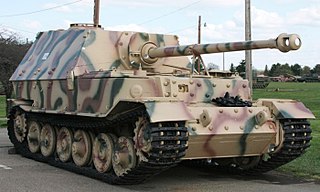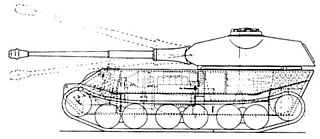
The Tiger II is a German heavy tank of the Second World War. The final official German designation was Panzerkampfwagen Tiger Ausf. B, often shortened to Tiger B. The ordnance inventory designation was Sd.Kfz. 182. It was known as King Tiger by Allied soldiers, and is also known under the informal name Königstiger. The name Königstiger was never used in contemporary German documentation, but was used extensively after the war.

The Panzer II is the common name used for a family of German tanks used in World War II. The official German designation was Panzerkampfwagen II.

The Panzerkampfwagen IV, commonly known as the Panzer IV, was a German medium tank developed in the late 1930s and used extensively during the Second World War. Its ordnance inventory designation was Sd.Kfz. 161.

Panzerkampfwagen VIII Maus was a German World War II super-heavy tank completed in late 1944. It is the heaviest fully enclosed armored fighting vehicle ever built. Five were ordered, but only two hulls and one turret were completed, the turret being attached, before the testing grounds were captured by advancing Soviet military forces.

The Elefant was a heavy tank destroyer used by German Wehrmacht Panzerjäger during World War II. Ninety-one units were built in 1943 under the name Ferdinand, after its designer Ferdinand Porsche, using tank hulls produced for the Tiger I tank design abandoned in favour of the sturdier Henschel design.

Nazi Germany developed numerous tank designs used in World War II. In addition to domestic designs, Germany also used various captured and foreign-built tanks.

The Entwicklung series, more commonly known as the E-Series, was a late-World War II attempt by Nazi Germany to produce a standardised series of tank designs. There were to be standard designs in five different weight classes from which several specialised variants were to be developed. This intended to reverse the trend of extremely complex tank designs that had resulted in poor production rates and mechanical unreliability.

The Panzerkampfwagen VII Löwe (Lion) was a design for a super-heavy tank created by Krupp for the German government during World War II. The project, initially code-named VK 70.01 (K), never left the drawing board, and was dropped on 5–6 March 1942, in favor of Porsche's heavier Panzer VIII Maus.

The 12.8 cm Selbstfahrlafette auf VK 30.01(H) "Sturer Emil", also called Panzer Selbstfahrlafette V, was an experimental World War II German self-propelled anti-tank gun. It was based on the Henschel VK 30.01 (H) chassis and armed with a Rheinmetall 12.8 cm Kanone 40 L/61 gun. This gun could traverse 7° to each side, elevate 10° and depress -15°. It carried 15 rounds for the main gun.

The Tiger I was a German heavy tank of World War II that operated beginning in 1942 in Africa and in the Soviet Union, usually in independent heavy tank battalions. It gave the German Army its first armoured fighting vehicle that mounted the 8.8 cm KwK 36 gun. 1,347 were built between August 1942 and August 1944. After August 1944, production of the Tiger I was phased out in favour of the Tiger II.

The VK 45.01 (P), also informally known as Tiger (P) or Porsche Tiger, was a gasoline-electric drive heavy tank prototype designed by Porsche in Germany. Losing to its Henschel competitor on trials, it was not selected for mass production and the Henschel design was produced as the Tiger I. Most of the already produced chassis were rebuilt as Elefant tank destroyers.

The VK 45.02 (P) was the official designation for an unsuccessful heavy tank project designed by Ferdinand Porsche in Nazi Germany during World War II to compete with Henschel's design.

The VK 20 series were the proposed replacements of the Panzer IV and Panzer III tanks with entries by MAN, Krupp and Daimler Benz. It was initially projected to weigh 20 tonnes, but grew to 24 tonnes. By November 1941, the designs almost reached completion but against the professional judgement of Wa Pruef 6, political interference in December 1941 led to all of the designs being dropped. The root of this adverse decision came from encounters with increasing numbers of T-34 and KV-1 tanks. Reichsminister Fritz Todt declared that a new tank, 30 tons in weight should be designed and produced. Oberst Fichtner argued that time would be lost developing this new 30 ton tank, the number produced would be reduced and engineer bridges could not support such a tank. This new tank chosen from the VK 30 series would become the Panther, replacing the VK 20 series. This decision would place the rushed MAN Panther into production as Germany's new standard medium tank, which was plagued with issues never fully addressed especially those caused by MAN's final drive. It would also arrive too late, with Germany's position in a steep decline, having lost the initiative.
The Vollketten 30 were two series of tank designs by Germany in World War II, originally intended as heavy 'breakthrough' tanks, but later switching completely to designate medium tanks to succeed the Panzer III, IV, and the planned VK 20 series tanks. These were requested in response to the Soviet T-34 and KV-1 tanks, with far heavier armour and armament than the mobile armoured vehicles fielded by the Wehrmacht at the time. Many German companies submitted projects, including Maschinenfabrik Augsburg-Nürnberg (MAN), Daimler-Benz (DB), Henschel, and Porsche. The winning entry tanks would go on to become the famous Tiger I and Panther tanks, and capable opponents to the T-34 if ultimately too late and at too small of a scale to affect the course of the war.

The VK 30.01 (D) and VK 30.02 (D), both tank designs made by Daimler Benz submitted for the VK 30 project, which eventually became the Panther tank, for use by the German army in WW2.

The VK 30.01 (H) is a German prototype heavy tank developed by Henschel in Germany during World War II. It was rejected for production. The chassis from this project went on to form the chassis for the Sturer Emil self-propelled anti-tank gun project.
















